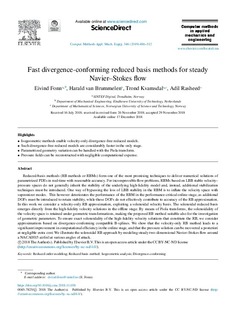| dc.contributor.author | Fonn, Eivind | |
| dc.contributor.author | Brummelen, Harald van | |
| dc.contributor.author | Kvamsdal, Trond | |
| dc.contributor.author | Rasheed, Adil | |
| dc.date.accessioned | 2019-02-25T09:49:41Z | |
| dc.date.available | 2019-02-25T09:49:41Z | |
| dc.date.created | 2019-01-09T18:33:14Z | |
| dc.date.issued | 2018 | |
| dc.identifier.citation | Computer Methods in Applied Mechanics and Engineering. 2018, 346 486-512. | nb_NO |
| dc.identifier.issn | 0045-7825 | |
| dc.identifier.uri | http://hdl.handle.net/11250/2587168 | |
| dc.description.abstract | Reduced-basis methods (RB methods or RBMs) form one of the most promising techniques to deliver numerical solutions of parametrized PDEs in real-time with reasonable accuracy. For incompressible flow problems, RBMs based on LBB stable velocity–pressure spaces do not generally inherit the stability of the underlying high-fidelity model and, instead, additional stabilization techniques must be introduced. One way of bypassing the loss of LBB stability in the RBM is to inflate the velocity space with supremizer modes. This however deteriorates the performance of the RBM in the performance-critical online stage, as additional DOFs must be introduced to retain stability, while these DOFs do not effectively contribute to accuracy of the RB approximation. In this work we consider a velocity-only RB approximation, exploiting a solenoidal velocity basis. The solenoidal reduced basis emerges directly from the high-fidelity velocity solutions in the offline stage. By means of Piola transforms, the solenoidality of the velocity space is retained under geometric transformations, making the proposed RB method suitable also for the investigation of geometric parameters. To ensure exact solenoidality of the high-fidelity velocity solutions that constitute the RB, we consider approximations based on divergence-conforming compatible B-splines. We show that the velocity-only RB method leads to a significant improvement in computational efficiency in the online stage, and that the pressure solution can be recovered a posteriori at negligible extra cost. We illustrate the solenoidal RB approach by modeling steady two-dimensional Navier–Stokes flow around a NACA0015 airfoil at various angles of attack. | nb_NO |
| dc.language.iso | eng | nb_NO |
| dc.publisher | Elsevier | nb_NO |
| dc.rights | Attribution-NonCommercial-NoDerivatives 4.0 Internasjonal | * |
| dc.rights.uri | http://creativecommons.org/licenses/by-nc-nd/4.0/deed.no | * |
| dc.title | Fast divergence-conforming reduced basis methods for steady Navier–Stokes flow | nb_NO |
| dc.type | Journal article | nb_NO |
| dc.type | Peer reviewed | nb_NO |
| dc.description.version | publishedVersion | nb_NO |
| dc.source.pagenumber | 486-512 | nb_NO |
| dc.source.volume | 346 | nb_NO |
| dc.source.journal | Computer Methods in Applied Mechanics and Engineering | nb_NO |
| dc.identifier.doi | 10.1016/j.cma.2018.11.038 | |
| dc.identifier.cristin | 1653615 | |
| dc.description.localcode | c ⃝2018The Author(s).Publishedby Elsevier B.V.This is an open access article under the CCBY-NC-ND license (http://creativecommons.org/licenses/by-nc-nd/4.0/). | nb_NO |
| cristin.unitcode | 194,63,15,0 | |
| cristin.unitname | Institutt for matematiske fag | |
| cristin.ispublished | true | |
| cristin.fulltext | original | |
| cristin.qualitycode | 2 | |

